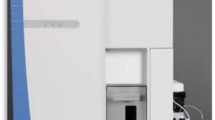Abstract
We report the coupling of nano-liquid chromatography (nano-LC) with an ambient dielectric barrier discharge ionization (DBDI)-based source. Detection and quantification were carried out by high-resolution mass spectrometry (MS), using an LTQ-Orbitrap in full scan mode. Despite the fact that nano-LC systems are rarely used in food analysis, this coupling was demonstrated to deliver extremely high sensitivity in pesticide analysis, with limits of detection (LODs) as low as 10 pg/mL. In all cases, the limits of quantification (LOQs) were compliant with the current EU regulation. An excellent signal linearity over up to four orders of magnitude was also observed. Therefore, this method can easily compete with conventional GC-(EI)-MS or LC-ESI-MS/MS methods and in some cases outperform them. The method was successfully tested for food sample analysis, with apples and baby food, extracted using the QuEChERS approach. Our results demonstrate an outstanding sensitivity (at femtogram level) and reproducibility of the nano-LC-DBDI coupling, capable of improving routine pesticide analysis. To the best of our knowledge, this is the most sensitive and reproducible plasma-MS-based method for pesticide analysis reported to date.






Similar content being viewed by others
References
Alder L, Greulich K, Kempe G, Vieth B. Residue analysis of 500 high priority pesticides: better by GC-MS or LC-MS/MS? Mass Spectrom Rev. 2006;25(6):838–65.
Karlsson KE, Novotny M. Separation efficiency of slurry-packed liquid chromatography microcolumns with very small inner diameters. Anal Chem. 1988;60(17):1662–5.
Hernández-Borges J, Aturki Z, Rocco A, Fanali S. Recent applications in nanoliquid chromatography. J Sep Sci. 2007;30(11):1589–610.
Mills M, Maltas J, Lough WJ. Assessment of injection volume limits when using on-column focusing with microbore liquid chromatography. J Chromatogr A. 1997;759(1):1–11.
Buonasera K, D’Orazio G, Fanali S, Dugo P, Mondello L. Separation of organophosphorus pesticides by using nano-liquid chromatography. J Chromatogr A. 2009;1216(18):3970–6.
Cappiello A, Famiglini G, Palma P, Mangani F. Trace level determination of organophosphorus pesticides in water with the new direct-electron ionization LC/MS interface. Anal Chem. 2002;74(14):3547–54.
Cappiello A, Famiglini G, Mangani F, Palma P, Siviero A. Nano-high-performance liquid chromatography–electron ionization mass spectrometry approach for environmental analysis. Anal Chim Acta. 2003;493(2):125–36.
Zhu KY, Leung KW, Ting AKL, Wong ZCF, Ng WYY, Choi RCY, et al. Microfluidic chip based nano liquid chromatography coupled to tandem mass spectrometry for the determination of abused drugs and metabolites in human hair. Anal Bioanal Chem. 2012;402(9):2805–15.
Asensio-Ramos M, D’Orazio G, Hernandez-Borges J, Rocco A, Fanali S. Multi-walled carbon nanotubes-dispersive solid-phase extraction combined with nano-liquid chromatography for the analysis of pesticides in water samples. Anal Bioanal Chem. 2011;400(4):1113–23.
Smoluch M, Mielczarek P, Silberring J. Plasma‐based ambient ionization mass spectrometry in bioanalytical sciences. Mass Spectrom Rev. 2015. doi:10.1002/mas.21460.
Wiley JS, García-Reyes JF, Harper JD, Charipar NA, Ouyang Z, Cooks RG. Screening of agrochemicals in foodstuffs using low-temperature plasma (LTP) ambient ionization mass spectrometry. Analyst. 2010;135(5):971–9.
Albert A, Kramer A, Scheeren S, Engelhard C. Rapid and quantitative analysis of pesticides in fruits by QuEChERS pretreatment and low-temperature plasma desorption/ionization orbitrap mass spectrometry. Anal Methods. 2014;6(15):5463–71.
Tang F, Chen J, Wang X, Zhang S, Zhang X. Development of dielectric-barrier-discharge ionization. Anal Bioanal Chem. 2015;407(9):2345–64.
Gilbert-López B, Geltenpoth H, Meyer C, Michels A, Hayen H, Molina-Díaz A, et al. Performance of dielectric barrier discharge ionization mass spectrometry for pesticide testing: a comparison with atmospheric pressure chemical ionization and electrospray ionization. Rapid Commun Mass Spectrom. 2013;27(3):419–29.
Hayen H, Michels A, Franzke J. Dielectric barrier discharge ionization for liquid chromatography/mass spectrometry. Anal Chem. 2009;81(24):10239–45.
Gilbert-López B, García-Reyes JF, Meyer C, Michels A, Franzke J, Molina-Díaz A, et al. Simultaneous testing of multiclass organic contaminants in food and environment by liquid chromatography/dielectric barrier discharge ionization-mass spectrometry. Analyst. 2012;137(22):5403–10.
Nudnova MM, Zhu L, Zenobi R. Active capillary plasma source for ambient mass spectrometry. Rapid Commun Mass Spectrom. 2012;26(12):1447–52.
Wolf J, Schaer M, Siegenthaler P, Zenobi R. Direct quantification of chemical warfare agents and related compounds at low ppt levels: comparing active capillary dielectric barrier discharge plasma ionization and secondary electrospray ionization mass spectrometry. Anal Chem. 2014;87(1):723–9.
Makarov A, Scigelova M. Coupling liquid chromatography to Orbitrap mass spectrometry. J Chromatogr A. 2010;1217(25):3938–45.
Acknowledgments
The authors acknowledge Dr. Juan Zhang from Novartis AG for the generous donation of the high-resolution Orbitrap-MS system used within this study. They also thank Christian Marro from the technical workshop of ETH for the valuable support and the construction of the experimental setup.
Author information
Authors and Affiliations
Corresponding author
Ethics declarations
Conflict of interest
The authors declare that they have no conflict of interest.
Electronic supplementary material
Below is the link to the electronic supplementary material.
ESM 1
(PDF 647 kb)
Rights and permissions
About this article
Cite this article
Mirabelli, M.F., Wolf, JC. & Zenobi, R. Pesticide analysis at ppt concentration levels: coupling nano-liquid chromatography with dielectric barrier discharge ionization-mass spectrometry. Anal Bioanal Chem 408, 3425–3434 (2016). https://doi.org/10.1007/s00216-016-9419-x
Received:
Revised:
Accepted:
Published:
Issue Date:
DOI: https://doi.org/10.1007/s00216-016-9419-x




